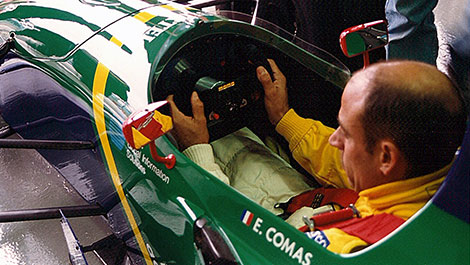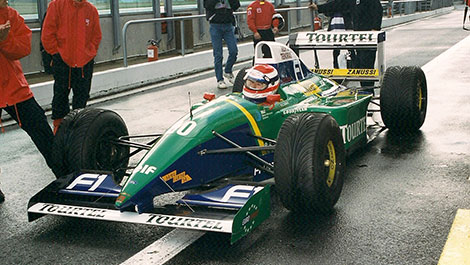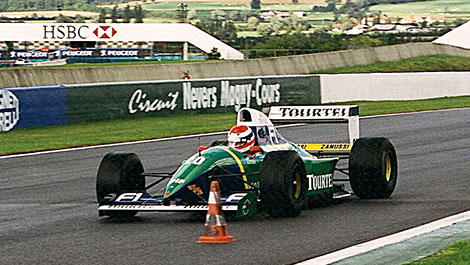Sep
10th
Stay connected Subscribe to our RSS feed
Before I get too old and start to forget a few things, I'd like to write a series of articles about some of the fantastic race cars I had the opportunity to drive over the years, starting with an F1 car that I took for a spin at Magny-Cours in France. Pure bliss!
It was the real thing, too — not one of those hybrids consisting of an F1 chassis with an endurance or Formula 3000 engine bolted to it.
More specifically, I drove Erik Comas' 1994 Larrousse LH94 equipped with a normally aspirated Series 7, 3.5L Ford HB V8 that produced 730 horsepower. Not a single part or component had been modified (including the paint) except the semi-automatic transmission.
F1 International
About 15 years ago, a wealthy French businessman bought some F1 cars and founded a company called F1 International, allowing anyone to drive these engineering marvels (or monsters or whatever you want to call them) for a certain price.
As an motor racing journalist, I was invited to participate. Thank heavens!
I headed to France on a cold and gloomy autumn day to drive this Larrousse. After getting familiar with the track in an F3 car, I was allowed five laps with an F1 — just over 20 kilometres in total.
My small size made me feel right at home inside the carbon monocoque. The steering wheel had two paddle shifters, but as was the case back then, the good old clutch pedal remained.
The director of the school leaned toward me and said that they had some issues with the transmission. OK, good to know.
I was a bit (should say pretty) nervous because the track was still wet and I'd be forced to use rain tires. As you can imagine, these were not ideal conditions for a first experience behind the wheel of a 700+ horsepower machine of just 600 kilos.
With some air-start assist, the V8 suddenly came to life and the vibrations tickled every inch of my spine. The engine idled at 4,000 rpm, but the sound was almost deafening.
I engaged first gear and the clutch proved surprisingly easy to modulate, provided I revved the engine up to about 7,000 rpm.
I exited the stands and the wind cleaned all the rain drops on my visor. The initial jitters made me keep a slow pace, as if there was an egg under my right foot.
Locked transmission
Upon approaching the Adelaide hairpin, I hit the brakes and the transmission locked in fifth gear. Since I didn't want to wreck anything, I stopped the car in the small exit lane on the left. The emergency staff arrived and put the transmission back to neutral so I could resume my driving session.
I tiptoed my way to the finish line, but now that the track was almost completely dry, I started to push the car a lot harder to really test its mettle. Time to mash the throttle. Whoa! This thing flies!
With the revs climbing all the way to the limit, I pulled the right paddle to shift into second gear. What happened next felt like a giant, violent kick in the butt.
My head slammed backward and I feared that the transmission was still stuck in first gear. I looked at the indicator and saw the “2” in bright red. OK then...
The same thing happened when I shifted into third gear. Heck, at the end of the operation, it was impossible for me to tell the difference between second and sixth gear without looking at the instrument panel.
All about the brakes
Honestly, I wasn't impressed with the car's top speed. Driving the Larrousse at 300 km/h felt a lot like doing 100 km/h in a production car.
The brakes are another story, however. There were two cones on the straight leading up to Adelaide to remind us when to apply the brakes, but they seemed to be way too close to the corner. And yet, the car slowed down in astonishingly quick fashion, causing my safety harness to loosen up a bit.
In the long and fast Estoril corner, the Larrousse tended to sway at a troubling rate. I was told this was caused by the significant caster angle of the large rear tires.
The transmission kept giving me trouble when downshifting, so I had to rely on heel-toe shifting to drop gears. I kept blipping the throttle and pulling the left paddle until the lower gear engaged. Vroam.... Voram.... Vroam....
That proved tedious and tiring at times, but something about the grating sound of the V8 invigorated me and captivated my senses.
My five-lap session at the world's most exhilarating amusement park ended in the blink of an eye, or so it seemed. I could have spent the entire day driving the Larrousse at Magny-Cours.
I undid the harness and slowly crawled out of the tight cockpit, a bit dizzy and with strained muscles in the front of my neck. I flashed a huge smile as my helmet came off, and understandably so: I had just driven an actual F1 car!
It was the real thing, too — not one of those hybrids consisting of an F1 chassis with an endurance or Formula 3000 engine bolted to it.
More specifically, I drove Erik Comas' 1994 Larrousse LH94 equipped with a normally aspirated Series 7, 3.5L Ford HB V8 that produced 730 horsepower. Not a single part or component had been modified (including the paint) except the semi-automatic transmission.
 |
| The author in the Larrousse LH94. (Photo: Jean-Claude Loustau) |
F1 International
About 15 years ago, a wealthy French businessman bought some F1 cars and founded a company called F1 International, allowing anyone to drive these engineering marvels (or monsters or whatever you want to call them) for a certain price.
As an motor racing journalist, I was invited to participate. Thank heavens!
I headed to France on a cold and gloomy autumn day to drive this Larrousse. After getting familiar with the track in an F3 car, I was allowed five laps with an F1 — just over 20 kilometres in total.
My small size made me feel right at home inside the carbon monocoque. The steering wheel had two paddle shifters, but as was the case back then, the good old clutch pedal remained.
The director of the school leaned toward me and said that they had some issues with the transmission. OK, good to know.
I was a bit (should say pretty) nervous because the track was still wet and I'd be forced to use rain tires. As you can imagine, these were not ideal conditions for a first experience behind the wheel of a 700+ horsepower machine of just 600 kilos.
With some air-start assist, the V8 suddenly came to life and the vibrations tickled every inch of my spine. The engine idled at 4,000 rpm, but the sound was almost deafening.
I engaged first gear and the clutch proved surprisingly easy to modulate, provided I revved the engine up to about 7,000 rpm.
I exited the stands and the wind cleaned all the rain drops on my visor. The initial jitters made me keep a slow pace, as if there was an egg under my right foot.
 |
| Leaving the (wet) pits... (Photo: Jean-Claude Loustau) |
Locked transmission
Upon approaching the Adelaide hairpin, I hit the brakes and the transmission locked in fifth gear. Since I didn't want to wreck anything, I stopped the car in the small exit lane on the left. The emergency staff arrived and put the transmission back to neutral so I could resume my driving session.
I tiptoed my way to the finish line, but now that the track was almost completely dry, I started to push the car a lot harder to really test its mettle. Time to mash the throttle. Whoa! This thing flies!
With the revs climbing all the way to the limit, I pulled the right paddle to shift into second gear. What happened next felt like a giant, violent kick in the butt.
My head slammed backward and I feared that the transmission was still stuck in first gear. I looked at the indicator and saw the “2” in bright red. OK then...
The same thing happened when I shifted into third gear. Heck, at the end of the operation, it was impossible for me to tell the difference between second and sixth gear without looking at the instrument panel.
All about the brakes
Honestly, I wasn't impressed with the car's top speed. Driving the Larrousse at 300 km/h felt a lot like doing 100 km/h in a production car.
The brakes are another story, however. There were two cones on the straight leading up to Adelaide to remind us when to apply the brakes, but they seemed to be way too close to the corner. And yet, the car slowed down in astonishingly quick fashion, causing my safety harness to loosen up a bit.
 |
| The braking zone at the Adelaide hairpin corner. (Photo: Jean-Claude Loustau) |
In the long and fast Estoril corner, the Larrousse tended to sway at a troubling rate. I was told this was caused by the significant caster angle of the large rear tires.
The transmission kept giving me trouble when downshifting, so I had to rely on heel-toe shifting to drop gears. I kept blipping the throttle and pulling the left paddle until the lower gear engaged. Vroam.... Voram.... Vroam....
That proved tedious and tiring at times, but something about the grating sound of the V8 invigorated me and captivated my senses.
My five-lap session at the world's most exhilarating amusement park ended in the blink of an eye, or so it seemed. I could have spent the entire day driving the Larrousse at Magny-Cours.
I undid the harness and slowly crawled out of the tight cockpit, a bit dizzy and with strained muscles in the front of my neck. I flashed a huge smile as my helmet came off, and understandably so: I had just driven an actual F1 car!
 The latest auto news, reviews, prices, product and vehicle releases.
The latest auto news, reviews, prices, product and vehicle releases.